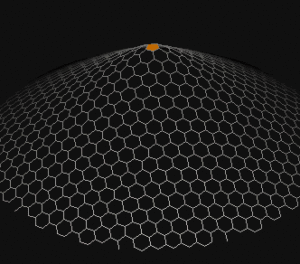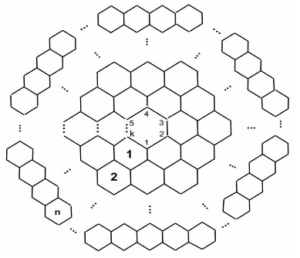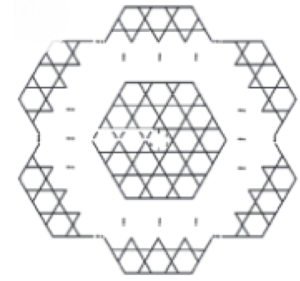Open Journal of Mathematical Analysis
ISSN: 2616-8111 (Online) 2616-8103 (Print)
DOI: 10.30538/psrp-oma2018.0012
Zagreb polynomials and redefined Zagreb indices for the line graph of carbon nanocones
Saba Noreen\(^1\), Atif Mahmood
Department of Mathematics and Statistics, The University of Lahore, Lahore Pakistan.; (S.N)
Department of Mathematics and Statistics, The University of Lahore, (Pakpattan Campus) Lahore Pakistan.; (A.M)
\(^{1}\)Corresponding Author; sabaalvi77@yahoo.com
Abstract
Keywords:
1. Introduction
Chemical graph theory is a subject which connects Mathematics, chemistry and graph theory. A topological index is a numeric number associated with molecular graph and this number correlate certain physico-chemical properties of chemical compounds. The topological indices such as the Wiener index, first and second Zagreb index, modified Zagreb index, Randi´c index and symmetric division index, Harmonic index, Invers sum index, Augmented Zagreb index, etc. are useful in prediction of bioactivity of the chemical compounds [1, 2, 3, 4, 5]. These indices capture the overall structure of compound and predict chemical properties such as strain energy, heat of formation, and boiling points etc. Carbon nanocones have been observed since 1968 or even earlier [6], on the surface of naturally occurring graphite. The importance of carbon nanostructures is due to their potential use in many applications including gas sensors, energy storage, nanoelectronic devices, biosensors and chemical probes [7]. Carbon allotropes such as carbon nanocones and carbon nanotubes have been proposed as possible molecular gas storage devices [8, 9]. More recently, carbon nanocones have gained increased scientific interest due to their unique properties and promising uses in many novel applications such as energy and hydrogen-storage [10]. Figure 1 and figure 2 are carbon nenocones.Figure 1. Carbon Nenocone \(CNC_{k}[5]\).
Figure 2. The Molecular graph of \(CNC_{k}[5]\).
Figure 3. Carbon nenocone \(CNC_{k}[n]\).
Figure 2. The line graph ofCarbon nenocone \(CNC_{k}[n]\).
- \(M_{4}(G,x)=\sum\limits_{uv\in E(G)}x^{d_{u}(d_{u}+d_{v})}\),
- \(M_{5}(G,x)=\sum\limits_{uv\in E(G)}x^{d_{v}(d_{u}+d_{v})}\),
- \(M_{a,b}(G,x)=\sum\limits_{uv\in E(G)}x^{ad_{u}+bd_{v}}\),
- \(M^{'}_{a,b}(G,x)=\sum\limits_{uv\in E(G)}x^{(a+d_{u})+(b+d_{v})}\).
- Re\(ZG_{1}(G)=\sum\limits_{uv\in E(G)}\frac{d_{u}+d_{v}}{d_{u}d_{v}}\),
- Re\(ZG_{2}(G)=\sum\limits_{uv\in E(G)}\frac{d_{u}d_{v}}{d_{u}+d_{v}}\),
- Re\(ZG_{3}(G)=\sum\limits_{uv\in E(G)}(d_{u}.d_{v})(d_{u}+d_{v})\).
2. Main Results
In this section, we will present our computational resultsTheorem 2.1 Let \(L(CNC_{k}[n])\) be the line graph of Carbon Nanocones \(CNC_{k}[n]\) . Then
- \(M_{1}(L(CNC_{k}[n]),x)=2kx^{5}+k(2n-1)x^{6}+2knx^{7}+3kn^{2}x^{8}\)
- \(M_{2}(L(CNC_{k}[n]),x)=2kx^{6}+k(2n-1)x^{9}+2knx^{12}+3kn^{2}x^{16}\)
- \(M_{3}(L(CNC_{k}[n]),x)=k[3n^2+2n-1]+2k(n+1)x\)
- \(M_{4}(L(CNC_{k}[n]),x)=2kx^{10}+k(2n-1)x^{18}+2knx^{21}+3kn^{2}x^{32}\)
- \(M_{5}(L(CNC_{k}[n]),x)=2kx^{15}+k(2n-1)x^{18}+2knx^{21}+3kn^{2}x^{32}\)
- \(M_{a,b}(L(CNC_{k}[n]),x)=2kx^{(2a+3b)}+k(2n-1)x^{3(a+b)}+2knx^{(3a+4b)}+3kn^{2}x^{4(a+b)}\)
- \(M^{'}_{a,b}(L(CNC_{k}[n]),x)=2kx^{(a+2)(b+3)}+k(2n-1)x^{(a+2)(b+3)}+2knx^{(a+2)(b+3)}+3kn^{2}x^{(a+2)(b+3)}\)
Proof. Let \(L(CNC_{k}[n])\) be the line graph of Carbon Nanocones \(CNC_{k}[n]\). From the graph of \(CNC_{k}[n]\)(figure 4) we can see that the total number of vertices are \(8k+2kn\) and total number of edges are \(k(n+1)(3n+1)\). The edge set of \(L(CNC_{k}[n])\) has following four partitions $$E_{1}=E_{\{2,3\}}=\{e=uv\in L(CNC_{k}[n]): d_{u}=2, d_{v}=3\}, $$ $$E_{2}=E_{\{3,3\}}=\{e=uv\in L(CNC_{k}[n]): d_{u}=3, d_{v}=3\}, $$ $$E_{3}=E_{\{3,4\}}=\{e=uv\in L(CNC_{k}[n]): d_{u}=3, d_{v}=4\}, $$ and $$E_{4}=E_{\{4,4\}}=\{e=uv\in L(CNC_{k}[n]): d_{u}=4, d_{v}=4\}. $$ Now, $$|E_{1}(L(CNC_{k}[n]))|=2k, $$ $$|E_{2}(L(CNC_{k}[n]))|=k(2n-1), $$ $$|E_{3}(L(CNC_{k}[n]))|=2kn, $$ and $$|E_{4}(L(CNC_{k}[n]))|=3kn^{2}. $$ \begin{eqnarray*} M_{1}(L(CNC_{k}[n]),x)&=& \sum\limits_{uv\in E(L(CNC_{k}[n]))}x^{d_{u}+d_{v}}\\ &=& \sum\limits_{uv\in E_{1}(L(CNC_{k}[n]))}x^{2+3}+\sum\limits_{uv\in E_{2}(L(CNC_{k}[n]))}x^{3+3}\\ &&+\sum\limits_{uv\in E_{3}(L(CNC_{k}[n]))}x^{3+4}+\sum\limits_{uv\in E_{4}(L(CNC_{k}[n]))}x^{4+4}\\ &=&|E_{1}(L(CNC_{k}[n]))|x^{5}+|E_{2}(L(CNC_{k}[n]))|x^{6}\\ &&+|E_{3}(L(CNC_{k}[n]))|x^{7}+|E_{4}(L(CNC_{k}[n]))|x^{8}\\ &=&2kx^{5}+k(2n-1)x^{6}+2knx^{7}+3kn^{2}x^{8}. \end{eqnarray*} \begin{eqnarray*} M_{2}(L(CNC_{k}[n]),x)&=& \sum\limits_{uv\in E(L(CNC_{k}[n]))}x^{d_{u}\times d_{v}}\\ &=& \sum\limits_{uv\in E_{1}(L(CNC_{k}[n]))}x^{2\times 3}+\sum\limits_{uv\in E_{2}(L(CNC_{k}[n]))}x^{3\times 3}\\ &&+\sum\limits_{uv\in E_{3}(L(CNC_{k}[n]))}x^{3\times 4}+\sum\limits_{uv\in E_{4}(L(CNC_{k}[n]))}x^{4\times 4}\\ &=&|E_{1}(L(CNC_{k}[n]))|x^{6}+|E_{2}(L(CNC_{k}[n]))|x^{9}\\ &&+|E_{3}(L(CNC_{k}[n]))|x^{12}+|E_{4}(L(CNC_{k}[n]))|x^{16}\\ &=&2kx^{6}+k(2n-1)x^{9}+2knx^{12}+3kn^{2}x^{16}. \end{eqnarray*} \begin{eqnarray*} M_{3}(L(CNC_{k}[n]),x)&=& \sum\limits_{uv\in E(L(CNC_{k}[n]))}x^{d_{v}-d_{u}}\\ &=& \sum\limits_{uv\in E_{1}(L(CNC_{k}[n]))}x^{3-2}+\sum\limits_{uv\in E_{2}(L(CNC_{k}[n]))}x^{3-3}\\ &&+\sum\limits_{uv\in E_{3}(L(CNC_{k}[n]))}x^{4-3}+\sum\limits_{uv\in E_{4}(L(CNC_{k}[n]))}x^{4-4}\\ &=&|E_{1}(L(CNC_{k}[n]))|x+|E_{2}(L(CNC_{k}[n]))|\\ &&+|E_{3}(L(CNC_{k}[n]))|x+|E_{4}(L(CNC_{k}[n]))|\\ &=&k[3n^2+2n-1]+2k(n+1)x. \end{eqnarray*} \begin{eqnarray*} M_{4}(L(CNC_{k}[n]),x)&=& \sum\limits_{uv\in E(L(CNC_{k}[n]))}x^{d_{u}(d_{u}+d_{v})}\\ &=& \sum\limits_{uv\in E_{1}(L(CNC_{k}[n]))}x^{2(2+3)}+\sum\limits_{uv\in E_{2}(L(CNC_{k}[n]))}x^{3(3+3)}\\ &&+\sum\limits_{uv\in E_{3}(L(CNC_{k}[n]))}x^{3(3+4)}+\sum\limits_{uv\in E_{4}(L(CNC_{k}[n]))}x^{4(4+4)}\\ &=&|E_{1}(L(CNC_{k}[n]))|x^{10}+|E_{2}(L(CNC_{k}[n]))|x^{18}\\ &&+|E_{3}(L(CNC_{k}[n]))|x^{21}+|E_{4}(L(CNC_{k}[n]))|x^{32}\\ &=&2kx^{10}+k(2n-1)x^{18}+2knx^{21}+3kn^{2}x^{32}. \end{eqnarray*} \begin{eqnarray*} M_{5}(L(CNC_{k}[n]),x)&=& \sum\limits_{uv\in E(L(CNC_{k}[n]))}x^{d_{v}(d_{u}+d_{v})}\\ &=& \sum\limits_{uv\in E_{1}(L(CNC_{k}[n]))}x^{3(2+3)}+\sum\limits_{uv\in E_{2}(L(CNC_{k}[n]))}x^{3(3+3)}\\ &&+\sum\limits_{uv\in E_{3}(L(CNC_{k}[n]))}x^{4(3+4)}+\sum\limits_{uv\in E_{4}(L(CNC_{k}[n]))}x^{4(4+4)}\\ &=&|E_{1}(L(CNC_{k}[n]))|x^{15}+|E_{2}(L(CNC_{k}[n]))|x^{18}\\ &&+|E_{3}(L(CNC_{k}[n]))|x^{28}+|E_{4}(L(CNC_{k}[n]))|x^{32}\\ &=&2kx^{15}+k(2n-1)x^{18}+2knx^{28}+3kn^{2}x^{32}. \end{eqnarray*} \begin{eqnarray*} M_{a,b}(L(CNC_{k}[n]),x)&=& \sum\limits_{uv\in E(L(CNC_{k}[n]))}x^{ad_{u}+bd_{v}}\\ &=& \sum\limits_{uv\in E_{1}(L(CNC_{k}[n]))}x^{2a+3b}\\ &&+\sum\limits_{uv\in E_{2}(L(CNC_{k}[n]))}x^{3a+3b}\\ &&+\sum\limits_{uv\in E_{3}(L(CNC_{k}[n]))}x^{3a+4b}\\ &&+\sum\limits_{uv\in E_{4}(L(CNC_{k}[n]))}x^{4a+4b}\\ &=&|E_{1}(L(CNC_{k}[n]))|x^{2a+3b}\\ &&+|E_{2}(L(CNC_{k}[n]))|x^{3a+3b}\\ &&+|E_{3}(L(CNC_{k}[n]))|x^{3a+3b}\\ &&+|E_{4}(L(CNC_{k}[n]))|x^{4a+4b}\\ &=&2kx^{(2a+3b)}+k(2n-1)x^{3(a+b)}\\ &&+2knx^{(3a+4b)}+3kn^{2}x^{4(a+b)}. \end{eqnarray*} \begin{eqnarray*} M^{'}_{a,b}(L(CNC_{k}[n]),x)&=& \sum\limits_{uv\in E(9L(CNC_{k}[n]))}x^{(a+d_{u})+(b+d_{v})}\\ &=& \sum\limits_{uv\in E_{1}(L(CNC_{k}[n]))}x^{(a+2)+(b+3)}\\ &&+\sum\limits_{uv\in E_{2}(L(CNC_{k}[n]))}x^{(a+3)+(3+b)}\\ &&+\sum\limits_{uv\in E_{4}(L(CNC_{k}[n]))}x^{(a+3)+(4+b)}\\ &&+\sum\limits_{uv\in E_{4}(L(CNC_{k}[n]))}x^{(4+a)+(4+b)}\\ &=&|E_{1}(L(CNC_{k}[n]))|x^{(a+2)+(b+3)}\\ &&+|E_{2}(L(CNC_{k}[n]))|x^{(a+3)+(3+b)}\\ &&+|E_{3}(L(CNC_{k}[n]))|x^{(a+3)+(4+b)}\\ &&+|E_{4}(L(CNC_{k}[n]))|x^{(4+a)+(4+b)}\\ &=&2kx^{(a+2)(b+3)}+k(2n-1)x^{(a+2)(b+3)}\\ &&+2knx^{(a+2)(b+3)}+3kn^{2}x^{(a+2)(b+3)}. \end{eqnarray*}
Theorem 2.2 Let \(L(CNC_{k}[n])\) be the line graph of Carbon Nanocones \(CNC_{k}[n]\). Then,
- Re\(ZG_{1}(L(CNC_{k}[n]))=\frac{3}{2}kn^{2}+\frac{5}{2}kn+k\),
- Re\(ZG_{2}(L(CNC_{k}[n]))=6kkn^{2}+\frac{45}{7}kn+\frac{9}{10}k\),
- Re\(ZG_{3}(L(CNC_{k}[n]))=6k(64n^{2}+46n+1)\),
Proof.
-
\begin{eqnarray*}
ReZG_{1}(L(CNC_{k}[n]))&=& \sum\limits_{uv\in E(L(CNC_{k}[n]))}\frac{d_{u}+d_{v}}{d_{u}.d_{v}}\\
&=& \sum\limits_{uv\in E_{1}(L(CNC_{k}[n]))}\frac{2+3}{2.3}\\
&&+\sum\limits_{uv\in E_{2}(L(CNC_{k}[n]))}\frac{3+3}{3.3}\\
&&+\sum\limits_{uv\in E_{3}(L(CNC_{k}[n]))}\frac{3+4}{3.4}\\
&&+\sum\limits_{uv\in E_{4}(L(CNC_{k}[n]))}\frac{4+4}{4.4}\\
&=&|E_{1}(L(CNC_{k}[n]))|\frac{5}{6}+|E_{2}(L(CNC_{k}[n]))|\frac{6}{9}\\
&&+|E_{3}(L(CNC_{k}[n]))|\frac{7}{12}+|E_{4}(L(CNC_{k}[n]))|\frac{8}{16}\\
&=&(2k)\frac{5}{6}+k(2n-1)\frac{6}{9}+(2kn)\frac{7}{12}+(3kn^{2})\frac{1}{2}\\
&=&\frac{5}{3}k+\frac{4}{3}kn-\frac{2}{3}k+\frac{7}{6}kn+\frac{1}{2}kn^{2}\\
&=&\frac{3}{2}kn^{2}+\left(\frac{24+21}{18}\right)kn+\left(\frac{5-2}{3}\right)k\\
&=&\frac{3}{2}kn^{2}+\frac{5}{2}kn+k.
\end{eqnarray*}
\begin{eqnarray*}
ReZG_{2}(L(CNC_{k}[n]),x)&=& \sum\limits_{uv\in E(L(CNC_{k}[n]))}\frac{d_{u}.d_{v}}{d_{u}+d_{v}}\\
&=& \sum\limits_{uv\in E_{1}(L(CNC_{k}[n]))}\frac{2.3}{2+3}\\
&&+\sum\limits_{uv\in E_{2}(L(CNC_{k}[n]))}\frac{3.3}{3+3}\\
&&+\sum\limits_{uv\in E_{3}(L(CNC_{k}[n]))}\frac{3.4}{3+4}\\
&&+\sum\limits_{uv\in E_{4}(L(CNC_{k}[n]))}\frac{4.4}{4+4}\\
&=&|E_{1}(L(CNC_{k}[n]))|\frac{6}{5}+|E_{2}(L(CNC_{k}[n]))|\frac{9}{6}\\
&&+|E_{3}(L(CNC_{k}[n]))|\frac{12}{7}+|E_{4}(L(CNC_{k}[n]))|\frac{16}{8}\\
&=&(2k)\frac{6}{5}+k(2n-1)\frac{9}{6}+(2kn)\frac{12}{6}+2(3kn^{2})\\
&=&\frac{12}{5}k+3kn-\frac{3}{2}k+\frac{24}{7}kn+6kn^{2}\\
&=&6kn^{2}+\left(\frac{24+21}{7}\right)kn+\left(\frac{24-15}{10}\right)k\\
&=&6kkn^{2}+\frac{45}{7}kn+\frac{9}{10}k.
\end{eqnarray*}
\begin{eqnarray*}
ReZG_{3}(L(CNC_{k}[n]),x) &=& \sum\limits_{uv\in E(L(CNC_{k}[n]))}(d_{u}.d_{v})(d_{u}+d_{v})\\
&=& \sum\limits_{uv\in E_{1}(L(CNC_{k}[n]))}(2.3)(2+3)\\
&&+\sum\limits_{uv\in E_{2}(L(CNC_{k}[n]))}(3.3)(3+3)\\
&&+\sum\limits_{uv\in E_{2}(L(CNC_{k}[n]))}(3.4)(3+4)\\
&&+\sum\limits_{uv\in E_{4}(L(CNC_{k}[n]))}(4.4)(4+4)\\
&=&|E_{1}(L(CNC_{k}[n]))|30+|E_{2}(L(CNC_{k}[n]))|54\\
&&+|E_{3}(L(CNC_{k}[n]))|84+|E_{4}(L(CNC_{k}[n]))|128\\
&=&(2k)\frac{5}{6}+k(2n-1)\frac{6}{9}+(2kn)\frac{7}{12}+(3kn^{2})\frac{1}{2}\\
&=&30(2k)+54k(2n-1)+84(2kn)+128(3kn^{2})\\
&=&60k+108kn-54k+168kn+384kn^{2}\\
&=&6k(64n^{2}+46n+1).
\end{eqnarray*}
Competing Interests
The author do not have any competing interests in the manuscript.Referance
- S. C., Mills, D., Mumtaz, M. M., & Balasubramanian, K. (2003). Use of topological indices in predicting aryl hydrocarbon receptor binding potency of dibenzofurans: A hierarchical QSAR approach.[Google Scholor]
- García, I., Fall, Y., & Gómez, G. (2010). Using topological indices to predict anti-Alzheimer and anti-parasitic GSK-3 inhibitors by multi-target QSAR in silico screening. Molecules, 15(8), 5408-5422.[Google Scholor]
- Verma, S., Le Bras, J., Jain, S. L., & Muzart, J. (2013). Thiol-yne click on nano-starch: An expedient approach for grafting of oxo-vanadium Schiff base catalyst and its use in the oxidation of alcohols. Applied Catalysis A: General, 468, 334-340.[Google Scholor]
- Verma, S., Le Bras, J., Jain, S. L., & Muzart, J. (2013). Nanocrystalline starch grafted palladium (II) complex for the Mizoroki–Heck reaction. Dalton Transactions, 42(40), 14454-14459.[Google Scholor]
- Verma, S., Tripathi, D., Gupta, P., Singh, R., Bahuguna, G. M., Chauhan, R. K., ... & Jain, S. L. (2013). Highly dispersed palladium nanoparticles grafted onto nanocrystalline starch for the oxidation of alcohols using molecular oxygen as an oxidant. Dalton Transactions , 42(32), 11522-11527.[Google Scholor]
- Gillot, J., Bollmann, W., & Lux, B. (1968). Cristaux de graphite en forme de cigare et a structure conique. Carbon , 6(3), 381-387.[Google Scholor]
- Iijima, S. (1991). Helical microtubules of graphitic carbon. nature, 354(6348), 56.[Google Scholor]
- Adisa, O. O., Cox, B. J., & Hill, J. M. (2011). Modelling the surface adsorption of methane on carbon nanostructures. Carbon , 49(10), 3212-3218.[Google Scholor]
- Zhao, J., Buldum, A., Han, J., & Lu, J. P. (2002). Gas molecule adsorption in carbon nanotubes and nanotube bundles. Nanotechnology , 13(2), 195.[Google Scholor]
- Li, X., Gutman, I., & Randić, M. (2006). Mathematical aspects of Randić-type molecular structure descriptors. University, Faculty of Science.[Google Scholor]
- Wu, B. (2010). Wiener index of line graphs. MATCH Commun. Math. Comput. Chem, 64(3), 699-706.[Google Scholor]
- Buckley, F., & Superville, L. (1981). Mean distance in line graphs. Congr. Numer, 32(1).[Google Scholor]
- DeniHuo, Y., Liu, J. B., Zahid, Z., Zafar, S., Farahani, M. R., & Nadeem, M. F. (2016). On Certain Topological Indices of the Line Graph of \(CNC_{k}[n]\) Nanocones. Journal of Computational and Theoretical Nanoscience , 13(7), 4318-4322. [Google Scholor]
- Iranmanesh, A., Gutman, I., Khormali, O., & Mahmiani, A. (2009). The edge versions of the Wiener index. Match , 61(3), 663.[Google Scholor]
- Xu, S. J., & Zhang, Q. X. (2013). The Hosoya Polynomial of One-Heptagonal Nanocone. Current Nanoscience, 9(3), 411-414.[Google Scholor]
- Ghorbani, M., & Jalali, M. (2009). The Vertex PI, Szeged and Omega Polynomials of Carbon Nanocones \(CNC_{4}\) (n). Match , 62(2), 353.[Google Scholor]
- Gutman, I., & Das, K. C. (2004). The first Zagreb index 30 years after. MATCH Commun. Math. Comput. Chem, 50(1), 83-92.[Google Scholor]
- Fath-Tabar, G. H. (2011). Old and new Zagreb indices of graphs. MATCH Commun. Math. Comput. Chem , 65(1), 79-84.[Google Scholor]
- Ranjini, P. S., Lokesha, V., Bindusree, A. R., & Raju, M. P. (2012). New bounds on Zagreb indices and the Zagreb co-indices. Boletim da Sociedade Paranaense de Matemática, 31(1), 51-55.[Google Scholor]
- Fath-Tabar, G. (2009). Zagreb polynomial and Pi indices of some Nano Structures. Digest Journal of Nanomaterials & Biostructures (DJNB), 4(1).[Google Scholor]
- Bindusree, A. R., Cangul, I. N., Lokesha, V., & Cevik, A. S. (2016). Zagreb polynomials of three graph operators. Filomat, 30(7), 1979-1986.[Google Scholor]
- Ranjini, P. S., Lokesha, V., & Usha, A. (2013). Relation between phenylene and hexagonal squeeze using harmonic index. International Journal of Graph Theory, 1(4), 116-121.[Google Scholor]




